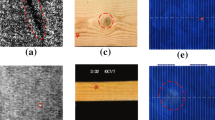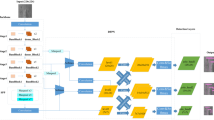Abstract
Surface defect detection is an important part of the process of product quality control in the industry. Automatic detection of surface defects based on machine learning is an up-and-coming research field, and there have been many successful cases. Deep learning has become the most suitable detection method for this task. Most algorithms require a large number of defect samples to achieve good results. However, defect samples in actual production are very limited. Although some unsupervised or semi-supervised methods can reduce training costs, their accuracy is difficult to guarantee, so they are difficult to be applied in industrial inspection. In this paper, we propose a detail-semantic guide network (DSGNet), which can achieve better result with fewer training samples. It is a two-stage neural network framework. In the first stage, we design a new semantic branch based on the modified residual shrinkage network and the proposed joined atrous spatial pyramid pooling (JASPP) module. This is the first time that residual shrinkage network is applied to defect detection and achieves good results. Also, we design a clear and efficient detail branch based on dense connection network. Specially, we propose a new detail-semantic guide module (DSGM), which can better integrate the feature information of the two branches. In the training phase, we propose a weight mask based on defect area to improve the ability of extracting small defects. We did experiments on four datasets and our method achieved excellent detection results even with only a small number of training samples.















Similar content being viewed by others
Code Availability
Not applicable, The code will be available on github in future.
References
Kwak J, Lee KB, Jang J, Chang KS, Kim CO (2019) Automatic inspection of salt-and-pepper defects in oled panels using image processing and control chart techniques. J Intell Manuf 30(3):1047–1055. https://doi.org/10.1007/s10845-017-1304-8
Qiu Y, Tang L, Li B, Niu S, Niu T (2020) Uneven illumination surface defects inspection based on saliency detection and intrinsic image decomposition. IEEE Access 8:190663–190676. https://doi.org/10.1109/access.2020.3032108
Liu L et al (2019) Planar eddy current sensor array with null-offset. IEEE Sens J 19(12):4647–4651. https://doi.org/10.1109/jsen.2019.2901351
Yuan F, Yu Y, Wang W, Xue K, Tian G (2021) Pulsed eddy current array design and electromagnetic imaging for defects detection in metallic materials. Nondestruct Test Evaluation 37 (1):81–99. https://doi.org/10.1080/10589759.2021.1909012
Dua G, Arora V, Mulaveesala R (2021) Defect detection capabilities of pulse compression based infrared non-destructive testing and evaluation. IEEE Sens J 21(6):7940–7947. https://doi.org/10.1109/jsen.2020.3046320
Liu J, Zhang Z, Lin Z, Chen H, Yin W (2021) Characterization method of surface crack based on laser thermography. IEEE Access 9:76395–76402. https://doi.org/10.1109/access.2021.3081435
Wu Q, Ding K, Huang B (2018) Approach for fault prognosis using recurrent neural network. J Intell Manuf 31(7):1621–1633. https://doi.org/10.1007/s10845-018-1428-5
Badmos O, Kopp A, Bernthaler T, Schneider G (2019) Image-based defect detection in lithium-ion battery electrode using convolutional neural networks. J Intell Manuf 31(4):885–897. https://doi.org/10.1007/s10845-019-01484-x
Çelik A, Küçükmanisa A, Sümer A, Çelebi AT, Urhan O (2020) A real-time defective pixel detection system for lcds using deep learning based object detectors. J Intell Manuf, https://doi.org/10.1007/s10845-020-01704-9
Wang Y, Zhou J, Zheng L, Gogu C (2020) An end-to-end fault diagnostics method based on convolutional neural network for rotating machinery with multiple case studies. J Intell Manuf, https://doi.org/10.1007/s10845-020-01671-1
Djavadifar A, Graham-Knight JB, Körber M, Lasserre P, Najjaran H (2021) Automated visual detection of geometrical defects in composite manufacturing processes using deep convolutional neural networks. J Intell Manuf, https://doi.org/10.1007/s10845-021-01776-1
Tabernik D, Šela S, Skvarč J, Skočaj D (2019) Segmentation-based deep-learning approach for surface-defect detection. J Intell Manuf 31(3):759–776. https://doi.org/10.1007/s10845-019-01476-x
Liu R et al (2020) Real-time defect detection network for polarizer based on deep learning. J Intell Manuf 31(8):1813–1823. https://doi.org/10.1007/s10845-020-01536-7
Cui L et al (2021) Sddnet: a fast and accurate network for surface defect detection. IEEE Trans Instrum Meas 70:1–13. https://doi.org/10.1109/tim.2021.3056744
Niu T, Li B, Li W, Qiu Y, Niu S (2022) Positive-sample-based surface defect detection using memory-augmented adversarial autoencoders. IEEE/ASME Trans Mechatron 27(1):46–57. https://doi.org/10.1109/tmech.2021.3058147
Jiang L, Wang Y, Tang Z, Miao Y, Chen S (2021) Casting defect detection in x-ray images using convolutional neural networks and attention-guided data augmentation. Measurement 170. https://doi.org/10.1016/j.measurement.2020.108736
Qiu L, Wu X, Yu Z (2019) A high-efficiency fully convolutional networks for pixel-wise surface defect detection. IEEE Access 7:15884–15893. https://doi.org/10.1109/access.2019.2894420
Liu G, Yang N, Guo L (2020) An attention-based network for textured surface anomaly detection. Appl Sci 10(18). https://doi.org/10.3390/app10186215
Zhao M, Zhong S, Fu X, Tang B, Pecht M (2020) Deep residual shrinkage networks for fault diagnosis. IEEE Trans Industr Inform 16(7):4681–4690. https://doi.org/10.1109/tii.2019.2943898
Weimer D, Scholz-Reiter B, Shpitalni M (2016) Design of deep convolutional neural network architectures for automated feature extraction in industrial inspection. CIRP Annals 65(1):417–420. https://doi.org/10.1016/j.cirp.2016.04.072
Božič J, Tabernik D, Skočaj D (2021) Mixed supervision for surface-defect detection: from weakly to fully supervised learning. Computers in Industry 129. https://doi.org/10.1016/j.compind.2021.103459https://doi.org/10.1016/j.compind.2021.103459
Huang Y, Qiu C, Yuan K (2018) Surface defect saliency of magnetic tile. The Visual Computer 36(1):85–96. https://doi.org/10.1007/s00371-018-1588-5
Ronneberger O, Fischer P, Brox T (2015) U-Net: Convolutional networks for biomedical image segmentation. Lect Notes Comput Sci 9351:234–241
Zhou Z, Siddiquee MMR, Tajbakhsh N, Liang J (2020) Unet++: Redesigning skip connections to exploit multiscale features in image segmentation. IEEE Trans Med Imaging 39(6):1856–1867. https://doi.org/10.1109/TMI.2019.2959609. https://www.ncbi.nlm.nih.gov/pubmed/31841402
Badrinarayanan V, Kendall A, Cipolla R (2017) Segnet: A deep convolutional encoder-decoder architecture for image segmentation. IEEE Trans Pattern Anal Mach Intell 39(12):2481–2495. https://doi.org/10.1109/TPAMI.2016.2644615
Lin G, Milan A, Shen C, Reid I (2017) Refinenet: Multi-path refinement networks for high-resolution semantic segmentation, pp 5168–5177
Yu CQ et al (2018) BiSeNet: bilateral segmentation network for real-time semantic segmentation. Lect Notes Comput Sci 11217:334–349
Peng C, Tian T, Chen C, Guo X, Ma J (2021) Bilateral attention decoder: A lightweight decoder for real-time semantic segmentation. Neural Netw 137:188–199. https://doi.org/10.1016/j.neunet.2021.01.021
Yang MY, Kumaar S, Lyu Y, Nex F (2021) Real-time semantic segmentation with context aggregation network. ISPRS J Photogramm Remote Sens 178:124–134. https://doi.org/10.1016/j.isprsjprs.2021.06.006
Cai J et al (2021) Real-time semantic segmentation of remote sensing images based on bilateral attention refined network. IEEE Access 9:28349–28360. https://doi.org/10.1109/access.2021.3058571
Hao R, Lu B, Cheng Y, Li X, Huang B (2020) A steel surface defect inspection approach towards smart industrial monitoring. J Intell Manuf, https://doi.org/10.1007/s10845-020-01670-2
He Y, Song K, Meng Q, Yan Y (2020) An end-to-end steel surface defect detection approach via fusing multiple hierarchical features. IEEE Trans Instrum Meas 69(4):1493–1504. https://doi.org/10.1109/tim.2019.2915404
Masci J et al (2012) Steel defect classification with max-pooling convolutional neural networks. Int Jt Conf Neural Netw (IJCNN), <GotoISI>://WOS:000309341300106 IEEE
Faghih-Roohi S et al (2016) Deep Convolutional Neural Networks for Detection of Rail Surface Defects. Int Jt Conf Neural Netw (IJCNN), pp 2584–2589 IEEE
Lin H, Li B, Wang XG, Shu YF, Niu SL (2019) Automated defect inspection of led chip using deep convolutional neural network. J Intell Manuf 30(6):2525–2534. https://doi.org/10.1007/s10845-018-1415-x
Li Y, Yang J (2021) Meta-learning baselines and database for few-shot classification in agriculture. Comput Electron Agric, vol 182, https://doi.org/10.1016/j.compag.2021.106055
Li Y, Yang J (2020) Few-shot cotton pest recognition and terminal realization. Comput Electron Agric, vol 169, https://doi.org/10.1016/j.compag.2020.105240
Li Y, Chao X (2021) Semi-supervised few-shot learning approach for plant diseases recognition. Plant Methods 17(1):68. https://doi.org/10.1186/s13007-021-00770-1. https://www.ncbi.nlm.nih.gov/pubmed/34176505
Racki D, Tomazevic D, Skocaj D (2018) A compact convolutional neural network for textured surface anomaly detection, pp 1331–1339
He Z, Liu Q (2020) Deep regression neural network for industrial surface defect detection. IEEE Access 8:35583–35591. https://doi.org/10.1109/access.2020.2975030
Tao X et al (2020) Weak scratch detection of optical components using attention fusion network. Int Conf Autom Sci Eng, pp 855–862 IEEE
Su BY et al (2021) Deep learning-based solar-cell manufacturing defect detection with complementary attention network. Ieee Trans Ind Inform 17(6):4084–4095. https://doi.org/10.1109/tii.2020.3008021
Sun J, Wang P, Luo YK, Li W (2019) Surface defects detection based on adaptive multiscale image collection and convolutional neural networks. Ieee Trans Instrum Meas 68(12):4787–4797. https://doi.org/10.1109/tim.2019.2899478
Zhu YS et al (2021) A lightweight multiscale attention semantic segmentation algorithm for detecting laser welding defects on safety vent of power battery. Ieee Access 9:39245–39254. https://doi.org/10.1109/access.2021.3064180
Schlegl T, Seebock P, Waldstein SM, Langs G, Schmidt-Erfurth U (2019) F-anogan: fast unsupervised anomaly detection with generative adversarial networks. Med Image Anal 54:30–44. https://doi.org/10.1016/j.media.2019.01.010
Bergmann P, Fauser M, Sattlegger D, Steger C, Ieee (2020) Uninformed students: student-teacher anomaly detection with discriminative latent embeddings. Conf Comput Vis Pattern Recognit, pp 4182–4191, IEEE
Wang T, Chen Y, Qiao MN, Snoussi H (2018) A fast and robust convolutional neural network-based defect detection model in product quality control. Int J Adv Manuf 94(9-12):3465–3471. https://doi.org/10.1007/s00170-017-0882-0
He K, Gkioxari G, Dollar P, Girshick R (2020) Mask r-cnn. IEEE Trans Pattern Anal Mach Intell 42(2):386–397. https://doi.org/10.1109/TPAMI.2018.2844175. https://www.ncbi.nlm.nih.gov/pubmed/29994331
Wu X, Qiu L, Gu X, Long Z (2021) Deep learning-based generic automatic surface defect inspection (asdi) with pixelwise segmentation. IEEE Trans Instrum Meas 70:1–10. https://doi.org/10.1109/tim.2020.3026801
Wang Z, Peng Y, Li D, Guo Y, Zhang B (2021) Mmnet: A multi-scale deep learning network for the left ventricular segmentation of cardiac mri images. Appl Intell, https://doi.org/10.1007/s10489-021-02720-9
Wu Y, Jiang J, Huang Z, Tian Y (2021) Fpanet: feature pyramid aggregation network for real-time semantic segmentation. Appl Intell, https://doi.org/10.1007/s10489-021-02603-z
Dong H et al (2020) Pga-net: Pyramid feature fusion and global context attention network for automated surface defect detection. IEEE Trans Ind Inform 16(12):7448–7458. https://doi.org/10.1109/tii.2019.2958826
Hu X, Jing L, Sehar U (2021) Joint pyramid attention network for real-time semantic segmentation of urban scenes. Appl Intell, pp 1–15
Dong XH, Taylor CJ, Cootes TF (2020) Defect detection and classification by training a generic convolutional neural network encoder. Ieee Trans Signal Process 68:6055–6069. https://doi.org/10.1109/tsp.2020.3031188
Li Y, Li J (2021) An end-to-end defect detection method for mobile phone light guide plate via multitask learning. IEEE Trans Instrum Meas 70:1–13. https://doi.org/10.1109/tim.2021.3053987
Funding
This work was supported by the Natural Science Foundation of China under Grant 51875113.
Author information
Authors and Affiliations
Contributions
Yihan Meng: methodology, investigation, code, data analysis, writing-original draft; He Xu: supervision; Zhen Ma: review and editing; Jiaqiang Zhou, Daquan Hui: writing and editing.
Corresponding author
Ethics declarations
Conflict of Interests
The authors declare that they have no competing interests.
Additional information
Availability of data and materials
All data generated or analyzed during this study are included in this paper.
Publisher’s note
Springer Nature remains neutral with regard to jurisdictional claims in published maps and institutional affiliations.
Rights and permissions
About this article
Cite this article
Meng, Y., Xu, H., Ma, Z. et al. Detail-semantic guide network based on spatial attention for surface defect detection with fewer samples. Appl Intell 53, 7022–7040 (2023). https://doi.org/10.1007/s10489-022-03671-5
Accepted:
Published:
Issue Date:
DOI: https://doi.org/10.1007/s10489-022-03671-5




